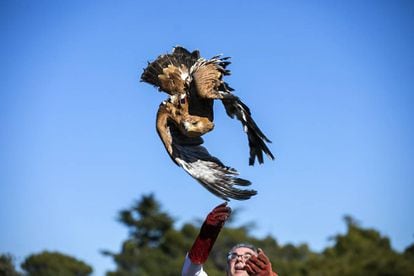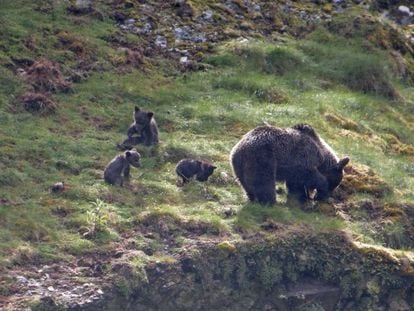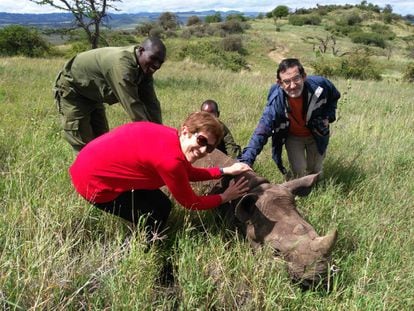The story of César, an imperial eagle released back into Madrid’s skies
The population of the species, which is native to the Iberian peninsula, suffered a great deal due to hunting. But numbers have bounced back, having tripled in the region since 2000


The skies of Madrid are in luck. An imperial eagle was released back into the wild last Wednesday in Galapagar, a town located in the northwest of Madrid. In a matter of seconds, it was lost among the mountains. His name is César, he is one year old, and as such has light-brown feathers in a number of different shades. Since his rescue as a newborn chick, he had been kept at the Madrid region’s Wild Animal Recovery Center (CRAS).
The imperial eagle is native to the Iberian Peninsula, but there was a time when the population in Madrid was suffering. Now, though, there are 71 pairs in the region, of the total of 400 that swoop majestically over Spanish skies. Not since the 1950s have there been so many sightings of the species. “Their population has tripled since 2000, and doubled since 2014,” explains Carlos Izquierdo, the Madrid regional environment chief.
We don’t usually give names to animals, but this time we made an exception
“We don’t usually give names to animals at CRAS because we don’t want to humanize them,” explains José Lara, head of the flora and fauna area in the Madrid regional government. “But this time we made an exception. César was found by a group of hikers and was transported to the Tres Cantos recovery center. He was dehydrated and had a problem with his tail, which indicates that he most likely fell out of his nest. We nursed him and he recovered and now, after a year, it’s time to see if he’s able to return to his natural habitat.”
But the work done for César in the center went beyond just nursing him back to health. “We’ve acted like his mother” explains Lara. “It wasn’t enough just to take care of him. We had to teach this animal how to hunt. He’s a hunter, and has claws that can pierce your skin. We had to teach him to hunt because if not he would not survive in nature.”
César will now start a new life in the area, searching for food and a mate. “And if he encounters another member of his species, he’ll try to take it down and defend himself,” Lara explains. This is why it is so difficult for the number of pairs to keep increasing, because each one occupies certain areas and they don’t like to share territory.
But while César seeks out that mate, he will not be completely alone. The recovery center has placed a transmitter on César, one that will fall off on its own in two years’ time. Until then, the device will provide detailed reports of his location and physical condition, allowing the center to study his progress.
It wasn’t enough just to take care of him. We had to teach him to hunt
The imperial eagle is still classed as an endangered species, but, as Izquierdo explains, “we now have more than ever. They had almost disappeared.”
“They were hunted and killed in the past,” explains Luis del Olmo, the Madrid regional environment and sustainability chief. “Bear in mind that 50 or 60 years ago, many Galapagar families lived on four rabbits and two partridges. That was why these animals were hunted, and why they were on the list of at-risk animals.”
But things started to change when Spanish naturalist Félix Rodríguez de la Fuente began to raise environmental awareness in Spain in the 1970s. In 1971, the Nature Conservation Institute (ICONA) was established and began to work in favor of certain animals considered to be pests, such as the weasel, the badger, the lynx, the wolf and the wildcat. In the 1980s, the first national decree to protect the eagle was passed, Olmo explains.
Despite all the work that has been done until now, the eagle is still officially classed as being in danger. “It is difficult to get animals off the list,” adds Olmo. “This was a genuine Iberian species. Now it has moved to North Africa. It is not the same as the golden eagle, which is found throughout northern Europe. The imperial eagle is just Spanish and Portuguese. Ninety-nine percent of them are scattered between Portugal and Spain, but now some of them have moved to North Africa, to Morocco.”
César will change color when he becomes an adult, at the age of four or five years old. Almost all of his plumage will turn a dark chocolate color and the feathers on his shoulders will turn white. If all goes well and he finds a mate, continues to eat – his diet is mostly hares, rabbits and dead animals – and survives the challenges of nature, he could roam the skies of Madrid for 20 or 25 more years.
English version by Asia London Palomba.












































